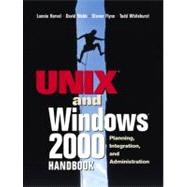Introduction
A few years ago, while teaching a course in UNIX system administration, a student approached me at the end of the day. He was concerned about implementing backup strategies for the systems he would soon have to manage. I was surprised. The gentleman had been an NT administrator for quite a while, managing a rather large infrastructure. When I took the time to explain how the concepts of backups were the same, only the commands differed, he was greatly relieved. That and many similar experiences over the last several years inspired this book. Our intent is to convey the fundamentals of system administration as an independent skill set, with the specific operating system as the application.
This book is an introduction to the complexity of supporting the user environment in a multi-vendor installation. UNIX and Windows 2000 Handbook: Planning, Integration & Administration is designed to assist system administrators of all levels in creating and maintaining a productive environment for their users. This book includes a discussion of the issues, guidelines for solving the related problems, technical examples where applicable, and a more philosophical discussion of the nature of support and the policy issues involved in planning and administering a heterogeneous environment.
Over the years, the separation among UNIX variants, and the resulting advocacy of administrators and programmers has resulted in a lack of commonality within the administrative functions of the systems. The inclusion of Windows NT/2000 and the increased capabilities of the personal computer have further complicated the issue of administration. Applications exist to span this diversity; implementations of DNS, NIS, and NFS are three notable examples. Throughout this book, we present the tasks of System Administration and how they are implemented in the UNIX and Windows 2000 environments. The intent is to view system administration tasks as independent concepts and the support of a specific operating system as an application of those concepts.
Who Is This Book For?
This book is intended for individuals who are competent users of one or more of the operating systems, but not necessarily a system administrator in any. The basic concepts are provided, as well as moderate to advanced discussions on topics related to creating an integrated user environment.
How this Book Is Organized
The book is structured to serve as a tutor as well as a reference. The fundamental issues of installation planning and the role of the system administrator will be thoroughly discussed. The book has been divided into three parts: Planning, Integration, and Administration. As the book progresses, the overlapping nature of these areas will become increasingly evident. We placed individual administration tasks in a particular area based on our perception of the task constraints. For example, upgrades and patches are administrative tasks, but careful planning is required for efficiency and stability. The latter constraint outweighs the former, and we placed the chapter in the Planning part of the book.
Part 1: Planning
The first section of this book relates to the foundational concepts required to begin system administration. In presenting these concepts, we introduce and explain the need for planning carefully. Planning is always good, but it becomes essential when attempting to integrate diverse operating systems in to a stable heterogeneous infrastructure. Though the material may be review for some readers, we recommend that you take the time to refresh your knowledge of these fundamentals.
Part 2: Integration
Networking, file sharing, information services, host recognition, and resource sharing are where the true work of integration begins. In this section we present chapters which introduce the tools and concepts necessary to create a distributed environment, including those tools and techniques which can be used to bridge the chasm between the Windows 2000 and UNIX worlds.
Part 3: Administration
Though not the most exciting section of the book, administration and maintenance of the heterogeneous infrastructure is necessary to maintain a stable environment for users. In this section we cover the tasks necessary to support a distributed environment and, where possible, ways to save time and resources.
We hope that this book will prove useful. There is a great deal of information presented here, but it is not possible to include everything. If you have any questions or comments, please send them to questions@system-administration.com or comments@system-administration.com You can also visit our website at www.system-administration.com for updates and Internet-based resources.








